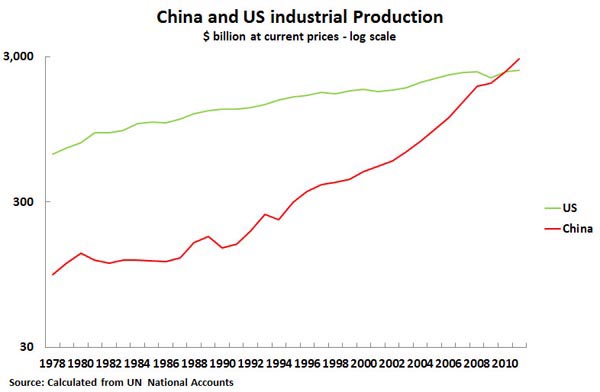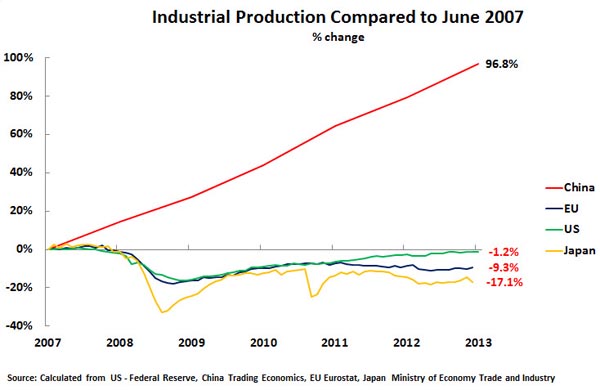China's new industrial revolution
- By John Ross
 0 Comment(s)
0 Comment(s) Print
Print E-mail China.org.cn, August 27, 2013
E-mail China.org.cn, August 27, 2013
For the first time in over a century, following the international financial crisis, the U.S. has been displaced as the world's largest industrial producer – this position now being taken by China. This period also witnessed the greatest shift in the balance of global industrial production in such a short period in world economic history.
In 2007, according to UN data, China's total industrial production was only 62 percent of the U.S. level. By 2011, the latest available comparable statistics indicated that China's industrial output had risen to 120 percent of the US level. China's industrial production in 2011 was $2.9 trillion compared to $2.4 trillion in the U.S. – this data is shown in Figure 1.
When the comparable data is released for 2012, China's lead will have increased substantially – between December 2011 and December 2012 China's industrial output increased by 10.3 percent whereas U.S. industrial production increased by only 2.7 percent. Calculations based on estimates in the CIA's World Factbook indicate in 2012 the value of China's industrial production was $3.7 trillion compared to $2.9 trillion for the US – which would mean China's industrial production was 126 percent of the US level.
Taking only manufacturing - excluding mining, electricity, gas and water production - in 2007 China's output was 62 percent of the U.S. level, by 2011 it was 123 percent. Again the gap has widened in 2012 and 2013.
No other country's industrial production now even approaches China - in 2011 China's industrial output was 235 percent of Japan's and 346 percent of Germany's.
World Bank data, using a slightly different calculation of value added in industry, confirms the shift. On World Bank data China's industrial production in 2007 was only 60 percent of the US level, whereas by 2011 it was 121 percent.
Therefore in only a six year period China has moved from its industrial production being less than two thirds of the US to overtaking the US by a substantial margin. If China was the 'workshop of the world' before the international financial crisis it is far more so now.
The trends producing these shifts are shown in Figure 2. In six years China's industrial output almost doubled while industrial production in the U.S., Europe and Japan has not even regained pre-crisis levels. To give precise statistics, between July 2007 and July 2013 China's industrial production increased by 97 percent while U.S. industrial output declined by 1 percent. Industrial production data for July is not yet available for the EU and Japan, but between June 2007 and June 2013 EU industrial output fell by 9 percent and Japan's by 17 percent.
It is this enormous rise in China's output which also drove the much discussed global shift in industrial production in favor of developing countries - in the six year period to June 2013, the latest date for which combined data is available, industrial production in advanced economies fell by 7 percent while output in developing economies rose by 65 percent.







